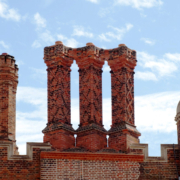Chimneys!

An Important Health Intervention
When cooking stoves are tested in the field the emissions of PM2.5 and CO are often higher than lab results (Roden et al., 2009). The wood can be wetter, the fire is made with less attention, and many real life variables create higher levels of pollution. It’s hard to imagine that unvented cookstoves for indoor use can be invented that will protect health when too much wet fuel is pushed quickly into the combustion chamber. Even modern cars make a lot of smoke when trying to combust bad quality gasoline.
Clean burning stoves require clean fuel just like automobiles. The sticks of wood need to be relatively dry and the metering of the sticks into the combustion chamber cannot happen too quickly. Perhaps batch fed pellet stoves will have more similar lab and field results if the pellets are well made, dry, and clean?
It’s illegal to install most types of unvented combustion devices in the United States and Europe. Even natural gas room heaters and gas cooking stoves are vented. For realistic protection of health, ARC consultants try to attach chimneys to biomass cookstoves whenever possible. When the stove smokes at least the pollution goes outside above the roof line where it becomes diluted.
Health Supportive Alternatives
Adding a chimney is not always a possibility. In these cases, it is helpful to move cooking out of the closed kitchen, for example under a veranda in the open air. Increasing air exchange rates by cooking under a veranda has been shown to dramatically lower concentrations of harmful PM and CO. Even opening the door and window in a test kitchen lowered the particulate matter 1-hour concentrations between 93% to 98% compared to the closed kitchen, and the CO 1-hour concentrations were 83% to 95% lower (Grabow et al., 2013).
Hundreds of years ago in
Europe chimneys were developed as a first step to take smoke and gases outside
of the kitchen. In the United States millions of wood burning heating stoves
are used indoors every winter. Chimneys transport the pollution outdoors where
it is mixed with the outside air.
References
Roden, C. A., Bond, T. C., Conway, S., Osorto Pinel, A. B., MacCarty, N., & Still, D. (2009). Laboratory and field investigations of particulate and carbon monoxide emissions from traditional and improved cookstoves. Atmospheric Environment, 43(6), 1170–1181. https://doi.org/10.1016/j.atmosenv.2008.05.041
Grabow, K., Still, D., & Bentson, S. (2013). Test Kitchen studies of indoor air pollution from biomass cookstoves. Energy for Sustainable Development, 17(5), 458–462. https://doi.org/10.1016/j.esd.2013.05.003

